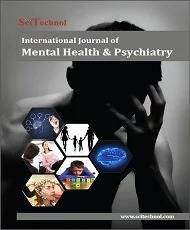Theme: Interpreting the strategies to deal with challenges & disputes through Social Sciences Research
Social Sciences 2018
Social Sciences and Interdisciplinary Studies Congress 2018
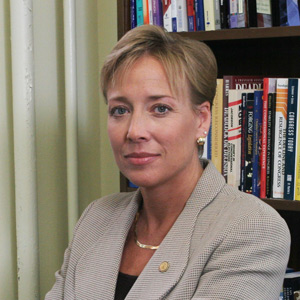

Dear Fellows:
On behalf of Social Sciences 2018, it is my pleasure to welcome participants the 2nd International Conference on Social Sciences and Interdisciplinary Studies.The focus of our meeting is the intersection of medicine and the social sciences. Bringing together scholars and practitioners from a vast array of fields, we seek to foster discussion, expand understanding and develop international collaborations to engage the global academic community on the issues of our time. The interdisciplinary examination of major policy issues from the perspective of researchers, policy makers, medical sociologists, medical practitioners, scholars and students we hope will provide an intellectually powerful and engaging experience.
Furthermore, I would like to thank the Conference Organizers, Sponsors, Keynote Speakers, Presenters, Session Chairs, and Participants who have come from near and far. All of you have contributed to what promises to be a most stimulating and enjoyable event.
Once again, I warmly welcome you and wish you a productive and pleasant stay in Rome
With Best Wishes,
Professor Lydia Andrade
University of the Incarnate Word, USA
Keynote Speaker & Member, Organizing Committee Social Sciences 2018
We are pleased to invite all to the '2nd International Conference on Social Sciences and Interdisciplinary Studies' which will take place during June 18-19, 2018 at Rome, Italy.
Social Sciences 2018 mainly aims in bringing a wide audience of academics like Sociologists, Social Scientists, Medical Sociologists, Public health Professionals, Social Science Researchers and practitioners, students from around the world under a single roof, where they discuss the research, achievements and advancements in the field of Social Science and Medicine. Social Science and Medicine provides an interdisciplinary forum for the dissemination of social science research on health around the world. This conference will continue with objectives of helping Social Science researchers in the Sociology field as well as general public to understand, empathize, and take prompt actions to help old people across the globe.
Rome is a gorgeous city with many hidden secrets poses one of the world’s most promising destinations to visit and experience the special tourist attractions. Attending and contributing to the conference will definitely enhance your cultural and scientific experience and open further opportunities for you and your career.
We Look forward welcome you to Rome, Italy.
AIMS of the Conference:
- Sharing of scientific knowledge and experience in all areas applied to Social Sciences, Public Health and related scientific fields;
- Strengthening and expanding the human network of all involved in this field in Europe and globally;
- Providing opportunities for Sociologists for their professional development
- Providing a forum for scientific exchanges on recent Social Sciences research
- Identify knowledge gaps that need to be filled;
- Promote the role of health promotion and prevention in improving quality of life of people
Benefits of Attending:
- Exchange ideas and network with leading Sociologists, Public Health Professionals, healthcare providers, nurses and researchers from more than 40 countries
- Discuss quality initiatives that can be applied in the practice
- Discuss ways to collaborate in putting quality initiatives in place throughout the Social Sciences research
- Participants can gain direct access to a core audience of professionals and decision makers and can increase visibility through branding and networking at the conference
- Learn and discuss key news and challenges with senior level speakers.
- With presentations, panel discussions, roundtable discussions, and workshops, we cover every topic from top to bottom, from global macro issues to strategies to tactical issues.
Target Audience:
- Sociologists
- Medical Sociologists
- Anthropologists
- Public Health Professionals
- Social Workers
- Medical Sociology Professionals
- Social Science Researchers
- Health Care Professionals
- Healthcare Researchers
- Healthcare Providers
- Healthcare Policymakers
- Psychologists
- Physicians
- Hospital and Skilled Nursing Home Administrators
- Community Care coordinators Nurses
- Crime lab Analysts
- Pharmacists
- Researchers and Students
- Epidemiologists
- Economists
- Business Entrepreneurs
- Pharmaceutical companies
- Public health departments
- Health Clubs
- Exhibitors and Sponsors
- Software developing companies
- Manufacturing Medical Devices Companies
Social Science & Medicine Research: Market Analysis 2018
Introduction & Scope
INTRODUCTION
OVERVIEW
Sociology is the study of an interdisciplinary forum for the dissemination of social science research on health including anthropology, economics, geography, psychology, social epidemiology, social policy, sociology, and health care practice, policy, and organization. It focuses mainly on the societal dimensions of health and medicine and it provides an analytical framework for understanding the social contexts of health, illness and health care. Central topics include the subjective experience of health and causes of illness, political, economic and environmental circumstances fostering ill health. Illness is a particular abnormal condition, a disorder of a structure or function that affects part or all of an organism.
SCOPE
Social Sciences Conference 2018 is a global platform provides an interdisciplinary forum for the dissemination of social science research on health including anthropology, economics, geography, psychology, social epidemiology, social policy, sociology, and health care practice, policy, and organization. It aims to discuss and learn about social aspects of health and disease, the social behavior of patients and health care providers, the social functions of health organizations and institutions, the social patterns and the utilization of health services, the relationship of health care delivery systems to other social institutions, and social policies toward health.
The sociological approach to medicine is one of the biggest subsections of the whole field of sociology, and has become an important component of health care disciplines such as public health, health care management, clinical medicine and nursing. It involves a sociological analysis of medical organizations, the actions of healthcare professionals, and the social and cultural effects of medical practice. The field of medical sociology regularly interacts with the sociology of science, knowledge, and technology studies, while also working alongside social epistemology. Medical sociologists are interested in the experiences of patients and are frequently found working at the fringes of public health, social work, demography and gerontology.
Many individuals receive health services because of illness, but this is not the only cause. From disability to emotional problems, from vaccinations to pregnancy, there are many reasons why people find themselves dealing with health professionals. Health care is intended to cover this wide range of activity – certainly not just what takes place in acute hospitals.
The aim of Social Sciences Congress is to provide suggestions and examples of how sociological concepts and insights can be used to help think about important contemporary issues in health care. For that reason, it has a practical as well as an academic purpose, aiming to contribute to improving the quality of interaction between patients and practitioners.
CONFERENCE HIGHLIGHTS:
- Social Sciences and Medical sociology
- Social Sciences and Community Studies
- Social Sciences and Epidemiology
- Social Sciences and Public Health
- Social Science and Nursing
- Social Sciences and Education
- Social Sciences and Social Work
- Social Sciences and Psychology
- Social Sciences and Cultural Studies
- Social Sciences and Natural Sciences
- Social Science and Anthropology
- Social Sciences and Gender Studies
- Social Sciences and Sociology
- Social Sciences and Political Studies
- Social Sciences and Criminal Justice
- Social Sciences and Philosophy
- Social Sciences and Disaster Management
- Social Sciences and Economics
- Social Sciences and Communication Studies
- Technology and Society
We believe these objectives can be achieved through disseminating workshops, symposiums and open discussion forums happening at our International Conference on Social Science and Interdisciplinary Studies 2018.
INTENDED AUDIENCE:
- Sociologists
- Medical Sociologists
- Anthropologists
- Public Health Professionals
- Social Workers
- Medical Sociology Professionals
- Social Science Researchers
- Health Care Professionals
- Healthcare Researchers
- Healthcare Providers
- Healthcare Policymakers
- Psychologists
- Physicians
- Hospital and Skilled Nursing Home Administrators
- Community Care coordinators Nurses
- Crime lab Analysts
- Pharmacists
- Researchers and Students
- Epidemiologists
- Economists
- Business Entrepreneurs
- Pharmaceutical companies
- Public health departments
- Health Clubs
- Exhibitors and Sponsors
- Software developing companies
- Manufacturing Medical Devices Companies
- Data Management Companies

Why Rome, Italy?
Rome has a status of the global city. It is known as the “Eternal city” and also “Caput Mundi,” coming from Latin and meaning capital of the world. The population of the city of Rome is around 2.7 million. The entire metropolitan area of Rome has an estimated 3.7 million people. According to the United Nations World Tourism Organisation (UNWTO), Europe was the most frequently visited region in the world in 2015, accounting for over half (51.4 %) of all international tourist arrivals, equivalent to some 609 million persons. The wealth of European cultures, the variety of its landscapes and the quality of its tourist infrastructure are likely to be an attraction. The center of Rome is compact, and wandering the ruins on foot is a great way to see the city. Street life is vibrant and constant. The architectural design is consuming, and close proximity of ancient sights make for a comfortable and convenient walk. Rome is easily divided into two regions: the inner city, within the Aurealian Wall, built in the late third century to enclose the area around the Seven Hills; and the sprawling outer city, with its suburbs. The historical center is a small area, located almost entirely on the eastern bank of the Tiber River. Monuments of Rome’s past eminence are located mostly within the historical center and are a stark contrast to the modern districts.
Social Science research is going in a vast way in the Italy and so many top most medical associations are present in the city. This gives boost to the social science and medicine research. Social science and Medicine are interrelated with each other and the research goes on endless. So many research companies specialized in healthcare and pharmaceutical are located in and around Rome, Italy. Europe is the hub of medical and social science research market. There are around 50 major sociological associations and 138 major medical associations across the Europe. European countries allocates sufficient budget for the research work going in the field of social sciences and medicine. Europe faces a demographic challenge caused by an ageing population and falling birth rates. This is putting straining on healthcare systems, which require the well and working to contribute to social systems, and on the economy, which is becoming increasingly dependent on older workers. 95% of Europe’s 25,000 medical technology companies are small and medium-sized enterprises (SMEs). The industry invests heavily to continuously improve its technologies and come up with breakthrough innovations. It files more patents than any other sector, provides over 575,000 jobs in Europe and delivers a positive trade balance of €14 billion.
Sociological & Medical Associations in Rome, Italy:
- Associazione Italiana di Sociologia (AIS)
- Associazione Italiana di Valutazione (AIV)
- Associazione Nazionale Sociologi (ANS)
- Società Italiana di Sociologia (SoIS)
- Società Italiana di Sociologia della Salute (SISS)
- Italian Medical Society of Great Britain (IMS)
- Italian Association of Demographic Education
Regional Sociological & Medical Associations in Europe:
- European Sociological Association (ESA)
- European Sociobiological Society (ESS)
- European Union Sociological Association (EUSA)
- European Association for Southeast Asian Studies (Euro SEAS)
- European Association of Social Anthropologists (EASA)
- European Educational Research Association (EERA)
- European Group for Organizational Studies (EGOS)
- European Social Science History Conference (ESSHC)
- European Society for Rural Sociology (ESR)
- International Visual Sociology Association (IVSA)
- Sociological Association of Ireland (SAI)
- Association of Sociologists of the Republic of Macedonia
- Polish Sociological Association (PTS)
- Russian Sociological Society (ROS)
- Finnish Anthropological Society (FAS)
- Bulgarian Sociological Association (BSA)
- Association Francaise de Sociologie (AFS)
Sociological Associations across the World:
- International Sociological Association (ISA)
- American Sociological Association (ASA)
- British Sociological Association (BSA)
- European Society for Health and Medical Sociology (ESHMS)
- Asia Pacific Sociological Association (APSA)
- Japan Sociological Society (JSS)
- Indian Sociological Society (ISS)
- Brazilian Sociological Society (BSS)
- The Australian Sociological Association (TASA)
- Chinese Sociological Association (CSA)
- South African Sociological Association
Social Science and Medicine is the study of an interdisciplinary forum for the dissemination of social science research on health including anthropology, economics, geography, psychology, social epidemiology, social policy, sociology, and health care practice, policy, and organization. A vast research work is going on in the field of Social Sciences & Medicine and variety of opportunities exists for those with advanced degrees concentrations and majors in the field of Medical Sociology. Sociology degree holders earns at different levels are explained the figure.
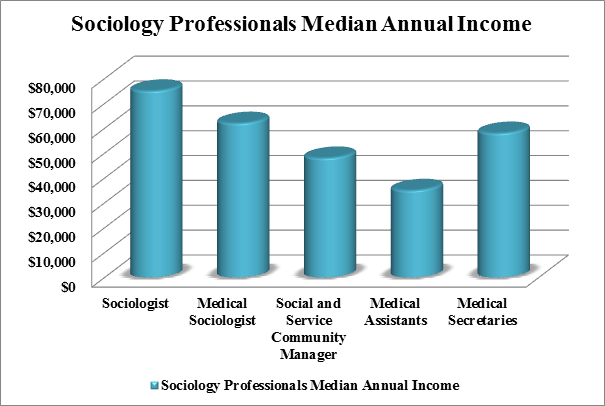
Employment:
A higher proportion of social scientists are in employment than STEM (science, technology, engineering and mathematics) or arts-humanities graduates: 84.2% of social science graduates, compared with 77.8% of STEM graduates and 78.7% of arts-humanities graduates, are in employment at this period. The difference between the employment rates of those who studied full-time and part-time is also much smaller among social science graduates: their rates of employment are consistently high. A smaller proportion of social science graduates are in further study, however – 10.1% compared with 17.3% from STEM and 11.5% from arts-humanities degree backgrounds.
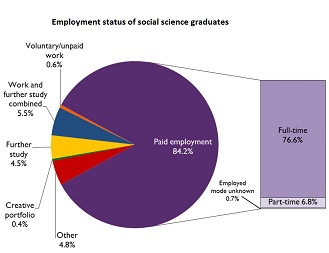
Occupation:
Among those in employment, 7 in 10 social scientists are in ‘professional’ or ‘associate professional and technical’ occupations within 3.5 years of graduating. This includes researchers, teachers, accountants, business analysts, recruitment and management consultants, legal professionals, town planners, social and community workers and insurance brokers, among many others. A greater proportion of social scientists are already ‘managers, directors and senior officials’ than graduates of any other subject group, 3.5 years after graduating from their first degrees: this accounts for 7.6% of employed social science graduates, compared with 3.6% of graduates in STEM and 6.2% in arts-humanities. ‘Business and administrative studies’ graduates are especially highly represented, followed by ‘architecture, building and planning’, and social studies graduates.
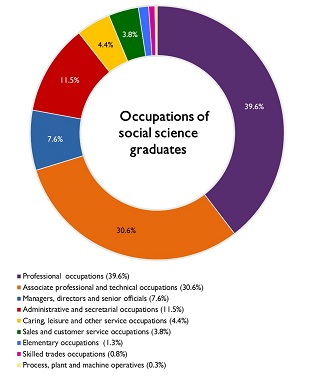
Industries:
Social scientists take up these occupations in a broad range of industries across the public, private and third sectors. Higher proportions of social scientists are employed in ‘professional, scientific and technical activities’ than any other subject group. This industry accounts for 1 in 5 employed social scientists (19.8%) – a considerably greater proportion than STEM (10.9%) or arts-humanities (14.2%) graduates. Social scientists remain more highly represented than STEM graduates even after discounting law and architecture graduates, whose vocational degrees are likely to steer them towards professional activities in particular.
The types of work classified under this category include experimental and market research management consultancy; advertising; accounting, book-keeping, auditing and legal activities; industrial design and architectural activities; labor recruitment and many others. Likewise, nearly twice the proportion of social scientists is employed in ‘financial and insurance activities’ compared with STEM or arts-humanities graduates – 7.1% compared with 3.7% and 3.9% respectively. This includes occupations in banks, insurance and pension funding, and other kinds of financial management. Graduates of business and administrative studies, social studies and law and are particularly represented.
After discounting graduates with degrees specifically in education (of whom 78.7% enter employment in the same industry), a smaller proportion of social scientists is employed in education (10.4%) than either STEM (14.3%) or arts-humanities graduates (25.4%). This appears consistent with the low content of social science in the National Curriculum. Nevertheless social scientists who become teachers may teach a range of subjects related to their degree.
The proportion of social science graduates employed in ‘human health and social work activities’ (12.6%) is less than half that of either STEM graduates (34.2%) – even after discounting those who studied medicine or dentistry (which brings the STEM proportion down to 28.4%). 1 in 13 social science graduates (7.7%) work in ‘public administration and defense’ or ‘compulsory social security.’ This sector includes activities in central, regional and local government, the provision of community services, and judicial activities, among others. Proportions of social scientists in ‘manufacturing’ or ‘information and communication’ are lower than those of STEM or arts-humanities graduates. Those in ‘wholesale and retail trade, and repair’ are fractionally higher than STEM graduates but lower than the national graduate average.
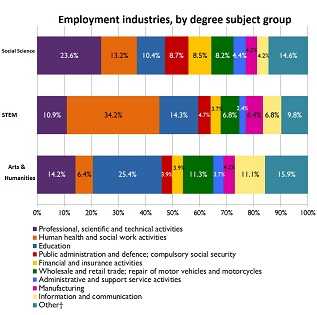
DISCLAIMER:
The information developed in this report is intended only for the purpose of understanding the scope of hosting related international meetings at the respective locations. This information does not constitute managerial, legal or accounting advice, nor should it be considered as a corporate policy guide, laboratory manual or an endorsement of any product, as much of the information is speculative in nature. Conference Organizers take no responsibility for any loss or damage that might result from reliance on the reported information or from its use.
Conference Series invites all the participants from all over the world to attend 2nd International Conference on Social Sciences and Interdisciplinary Studies during June 18-19, 2018 at Rome, Italy which includes prompt Keynote presentations, Oral talks, Poster presentations and Exhibitions.
Social Sciences and Interdisciplinary Studies 2018 is a global platform provides an interdisciplinary forum for the dissemination of social science research on health including anthropology, economics, geography, psychology, social epidemiology, social policy, sociology, law, criminology and health care practice, policy, and organization. It aims to discuss and learn about social aspects of health and disease, the social behavior of patients and health care providers, the social functions of health organizations and institutions, the social patterns and the utilization of health services, the relationship of health care delivery systems to other social institutions, and social policies toward health.
Social Sciences and Medical Sociology
The sociological approach to medicine is one of the biggest subsections of the whole field of sociology, and has become an important component of health care disciplines such as public health, health care management, clinical medicine and nursing. It involves a sociological analysis of medical organizations, the actions of healthcare professionals, and the social and cultural effects of medical practice. The field of medical sociology regularly interacts with knowledge, sociology of science and the technology studies. Medical sociologists are interested in the experiences of patients and are frequently found working at the fringes of public health, social work, gerontology and demography. Concepts such as medicalization have added to the broader understanding of social control and social order, while medicine recognizes sociology as an important discipline that is capable of making a great contribution to the application and understanding of health care.
Social Sciences and Community Studies
Community Studies is a field drawing on both Sociology and Anthropology and the social research methods for ethnography and member perception in the study of community. Community studies is variously a sub-discipline of anthropology or sociology, or an independent discipline. It is often interdisciplinary and intended for practical applications as opposed to simply hypothetical points of view. Community studies is sometimes combined with other fields, like Urban and Community Studies, Health and Community Studies, or Family and Community studies.
Social Sciences and Epidemiology
The focus of epidemiological research is on infections and deficiencies. In the middle of the 20th century epidemiologists began to look also at common chronic conditions and the great advances have been made in the understanding of the factors affecting the prevalence and risk of such diseases. It examines the prevalence of various diseases within a population and investigates if there is a correlation with, for example, exposure to hormones, infectious agents, radiation, stress or cigarette smoke, and with conditions such as myocardial infarction, lung cancer, obesity, hypertension etc. This knowledge is then used to develop approaches to disease prevention. Important advances have been made by researchers in environmental medicine, occupational medicine and social medicine. It also has an important role to play as the demands for efficiency and cost-effectiveness increase the need for healthcare research. The methodology also makes important contributions to clinical research when investigating treatment outcomes, prognosis and side-effects.
Social Sciences and Public Health
Public health concentrates on the health of the general population in total. It addresses monitoring and surveillance of nutritional status and nutritional situations in groups or populations in danger, distinguishes and analysis behavioral, sociocultural, financial, political, and ecological determinants of nutritional related public health. The 20th century gave frightful case of violence, neglect, injustice, suffering and death that came about negligence of principal qualities and objectives of Public health, additionally Public health has numerous gigantic accomplishments amazingly including numerous years of future all around. A definitive objective of Public health is the biologic, physical and mental prosperity of the general public by drawing out life and advancing sound way of life. It incorporates pre-arranging of regular and man-made disasters. Different Health frameworks around the globe consolidate Public health exercises and duties in an unexpected way, contingent upon the structure, financing, and accessibility of human services in a population.
Nursing care is the protection, promotion, and optimization of health and abilities, facilitation of healing, prevention of illness and injury, alleviation of suffering through the diagnosis and treatment of human response, and advocacy in the care of individuals, families, groups, communities, and populations. According to the US Bureau of Labor Statistics, the nursing profession is growing at a rapid rate. Growth for registered nurses is projected at 19 %, which is must faster than the average growth for other professions. This growth will result in approximately more than a half million new nursing openings by the year 2022. Nursing is a great job in our current market, offering high job demand, work satisfaction, and good salary for new graduates. Experts in the field expect continued job growth for nurses and hope that there will be enough nurses to fill those jobs. Nurses are also often secure in their roles with a history of hospitals continuing to hire during periods of recession. One survey of 141 facilities nationwide found that nearly 25% of the hospitals reported a vacancy rate of 10% or higher in 2015, compared with only 5% in 2012, according to a report published the turnover rate for bedside nurses jumped from 11% to 16% from 2011 to 2015.
Good education improves health; poor health harms education. Similarly, physical activity and exercise improves motivation, reduces unhappiness, and improves learning – today, just 55% of children are physically active. Training is a standout amongst the most vital sociologies includes the investigation of individuals and how they interface with each other, with their social and political organizations and with their surroundings. The sociology training incorporates an expansive scope of study including the reasons for adolescent wrongdoing, and expert advancement open doors for those working in schools, schools, colleges and related associations.
Social Sciences and Social Work
Social work developed in the 19th century, with roots in voluntary philanthropy and grassroots organizing. However, the act of responding to social needs have existed long before then, primarily from private charities, and religious organizations. The effects of the Industrial Revolution and the Great Depression, placed pressure on social work to be a more defined discipline. About 82% of social workers are now female and fewer men are entering the profession than ever before. Overall employment of social workers is projected to grow 15 percent from 2016 to 2026, much faster than the average for all occupations. Employment growth will be driven by increased demand for healthcare and social services. Women constitute 81.6% of social workers, 69.9% of counselors, and 82.4% of social and human service assistants. Moreover, men account for less than 10% of social workers under the age of 34, suggesting that their numbers will dwindle even more in the next couple decades.
Social Sciences and Political Studies
Man is a social animal. He cannot live in isolation, because he is not self-sufficient and the natural instinct to survive compels him to live a collective life. According to Aristotle, this collective life necessitates a political mechanism of rules, regulations and leadership. An organized society needs some system to make and enforce rules for orderly behavior in society. This led to the evolution of a political system with elaborate governmental institutions & procedures in each society. Therefore, man is also a political animal. Political science is one of the oldest subjects of study of this political life of man. The study of politics is both humanistic and scientific, and is centuries old. Aristotle called it the "queen of the sciences". Today’s political research involves highly scientific and rigorous attempts to understand human behavior and world events. Political scientists provide the frameworks from which journalists, special interest groups, politicians, and the electorate analyze issues.
Social Sciences and Psychology
Psychology is the investigation of conduct and psyche, grasping all parts of cognizant and oblivious experience and in addition thought. It is a scholarly teach and a sociology which tries to comprehend people and gatherings by building up general standards and inquiring about particular cases. According to the results of the 2013 out of approximately 188,000 people who were coded as psychologists, 3 about 30,000 were either retired (7.5%) or semi-retired (8.3 percent). Of those who were active in the workforce, 47.6 percent held master's degrees, while 52.4% (approximately 83,000 individuals) held professional (8.9%) or doctoral (43.6%) degrees. the number of active psychologists slightly increased by 3.2% from 2005-2013. The the percentage of female active psychologists in the workforce increased by 10% (from 58.2% to 68.3%). In 2013, for every male active psychologist, there were 2.1 female active psychologists in the workforce. The number of female active psychologists surpassed the number of male active psychologists at all age groups between ages 20 and 65.
Social Sciences and Humanities
The humanities can be described as the study of how people process and document the human experience. Since humans have been able, we have used philosophy, literature, religion, art, music, history and language to understand and record our world. To listen to many politicians, one would think talented science students are abandoning laboratories to study the humanities. The percentage of students completing humanities majors is lower today than in the late 1960s. As a percentage of all the core disciplines in the humanities disciplines fell in 2014 to their lowest recorded level, 6.1 percent, in all years going back to 1948, the period for which the academy has reliable numbers. As recently as the early 1990s. The drops in the last two years that the academy analyzed were not identical for all humanities disciplines, but the majors that attract the most students, English and history, fell by 8 percent and 12 percent, respectively. The largest percentage drops were in archaeology and classical studies-both down by 19%.
Social Sciences and Natural Sciences
Natural science is concerned about the expectation, description and understanding of natural phenomena, in light of observational and exact confirmation. It utilize the logical techniques to dive deep into insights concerning the regular conduct and common condition. Sociologies, similar to brain science, human studies, and financial matters are investigations of individuals with respect to their improvement and conduct then again Natural sciences like material science and earth sciences include the physical world. Employment in STEM occupations grew by 10.5%, or 817,260 jobs, between May 2009 and May 2015, compared with 5.2% net growth in non-STEM occupations. Employment in Software occupations was nearly 3.2 million in May 2009 and nearly 3.9 million in May 2015. Employment of engineers was nearly 1.5 million in May 2009, compared with over 1.6 million in May 2015.
Social Science and Anthropology
Social Sciences and Anthropology deals with different aspects of humans within the past and present societies and it gives a systematic structure to understanding the social settings of well-being. Social Anthropology, Cultural Anthropology, Medical Anthropology are different branches of Anthropology. For the past 20 years, cultural anthropology accounted for an average 50% of new PhDs awarded in the U.S.; archaeology - 30%; biological/physical 10%; linguistic anthropology 3%; applied/other 7%. The figures for 1994-95 are, respectively, 52%, 24%, 10%, 1% and 12%. In the early 1970s, 74% of PhDs took jobs in academic departments of anthropology (13% took jobs in research centers and other academic departments; 13% took nonacademic jobs. From the mid-1970s through 1990, the percent taking jobs in anthropology departments dropped to 38% (21% took jobs in research centers and other academic departments; 41% took nonacademic jobs). By the year 1995, approximately 11,000 men and women (representing 0.004% of the population) had received a doctorate in anthropology. By the year 2025 using the assumptions noted above the straight-line forecasting yields a grand total of 12,000 researchers awarded anthropology PhDs 1,000 more than today. If the value of a commodity is determined by its scarcity alone, future anthropologists will be valued indeed.
Social Sciences and Gender Studies
The main focus of gender studies is on investigating how perceptions of gender, sex and sexuality, in interaction with other powers structures like class, ethnicity and functionality, are filled with content and given meaning in various historic, geographic, political and social contexts. Gender Studies is a field for interdisciplinary studies gave to gender orientation personality and gendered portrayal as focal classes of analysis. This field includes men's studies, women's studies and queer studies. These disciplines study gender and sexuality in the fields of language, literature, geography, political science, history, sociology, anthropology, human development, law, and medicine. It also analyzes how race, ethnicity, class, location, nationality, and disability intersect with the categories of sexuality and gender. Women's and gender studies degrees in the United States have increased more than 300% in the past quarter-century, with more than 2,000 such degrees getting handed out in 2015 alone, according to a new report. Women's studies programs began popping up on college campuses in the 1960s and have become more popular than ever in recent years.
The most distinctive feature of human life is its social character. All human beings have to interact with other human beings in order to survive. Man’s behavior in society is determined mainly by two forces—physical and social which he has been trying to understand and control from time immemorial. Nevertheless man has been trying since ancient times to take stock of his social environment and to attempt to understand the problems created by it. But in these early stages man carried on the study not of society but of the different aspects of society and that gave rise to different social sciences, like History, Economics, and Political Science. Anthropology, Psychology, etc. Sociology essentially and fundamentally deals with that network of social relationships we call society. No other science takes that subject for its central concern. As a share of all associate degrees, those with a significant humanities component rose from 25.8% in 1987 to 38.9% in 2013. During the same time period, the share of degrees classified in professional fields fell from 57.5% to 49.2%.
Social Sciences and Criminal Justice
Criminal justice involves the investigation, prosecution and punishment or rehabilitation of those accused and convicted of crimes. Resources available from governmental bodies may impact many criminal justice jobs. Because crime prevention and protection of rights are essential government functions, however, opportunities should exist even if the number of Work oppertunity grows at a slow rate. According to the U.S. Bureau of Labor Statistics, police and detective work will increase by 7% through 2020, below the 14% growth rate for all jobs. Police and sheriff's departments in highly populated areas regularly have openings due to high turnover rates for officers and deputies.
Social Sciences and Disaster Management
Disaster Management can be defined as the association and administration of assets and duties regarding managing humanitarian aspects of crises, in particular preparedness, response and recovery keeping in order to decrease the the impact of disasters. Last year, 376 natural triggered disasters were registered. After the lowest number since the beginning of the century in 2014 (330), this increase could be a sign of a reversal in the trend to decline in the annual number of disasters since 2005, even if the 2015 number remains below its average annual for the period 2005-2014 (380). Last year natural disasters made still 22,765 deaths, a number largely below the annual average for years 2005-2014 (76,416), and made 110.3 million victims worldwide, also below the 2005-2014 annual average (199.2 million). Like the other indicators, with estimates placing economic damages at US$ 70.3 billion, natural disasters costs were, in 2015, significantly below their decennial average of US $ 159.7 billion.
The field of economics rewards creative and curious thinkers. Economists study data and statistics in order to spot trends in economic activity, economic confidence levels, and consumer attitudes and assess the information using advanced methods in statistical analysis, mathematics, computer programming; finally they make recommendations about ways to improve the efficiency of a system or take advantage of trends as they begin. The number of privately owned economic consulting firms has grown by about 150% over the last 6 years, to reach about 5,000 as of 2017. These firms offer advice to and predict economic scenarios for individuals and large corporations, and occasionally act as consultants to branches of the government. However, universities and research groups remain the largest employers of economists, followed by the government. Economists work closely with each other and share ideas fairly easily, which leads to a strong sense of community within the. International economists may spend as much as 30% of their time traveling and 40% of the time on the researching current trends in foreign economic systems. Other fields include agricultural economics, labor economics, and law and economics.
Social Sciences and Communication Studies
Communication studies integrates the aspects of both social sciences and humanities. As a social science, the discipline often overlaps with sociology, psychology, anthropology, political science, biology, public policy, and economics, amongst others. From a humanities perspective, communication is concerned with persuasion. The focus on research and development sets communication studies apart from general degrees in communication. Many of the students chose the field do so in order to pursue doctoral level ambitions. Requirements for undergraduate degrees focus on preparing students to ask questions concerning the nature of communication in society and the development of communication as a specific field.
In the past few decades there has been a revolution in computing and communications, and all indications are that technological progress and use of information technology will continue at a rapid pace. Accompanying and supporting the dramatic increases in the power and use of new information technologies has been the declining cost of communications as a result of both technological improvements and increased competition. Today, innovations in information technology are having wide-ranging effects across numerous domains of society, and policy makers are acting on issues involving economic productivity, intellectual property rights, privacy protection, and affordability of and access to information. Choices made now will have long lasting consequences, and attention must be paid to their social and economic impacts. Computers and communication technologies also promote more market-like forms of production and distribution. The on-going computing and communications revolution has numerous economic and social impacts on modern society and requires serious social science investigation in order to manage its risks and dangers.
Related Medical Sociology Conferences | Sociology conferences | Healthcare Conferences
3rd World Public Health Conferences, February 26-28, 2018 London, UK; 13th World Healthcare Conferences, June 14-15, 2018 Dublin, Ireland; 6th International Medical Informatics Conferences, July 5-6, 2018 Berlin, Germany; 2nd International Geriatrics Conferences, July 23-24, 2018 Lisbon, Portugal; 24th International Social Development Conferences, October 13-14, 2017, Warsaw, Poland; International Social Sciences Conferences, July 25-27, 2018, Granada, Spain; 20th International Medical Sociology Conferences, June 14-15, 2018, Vienna, Austria
Related Epidemiology Conferences | Sociology conferences | Healthcare Conferences
International Antimicrobial Resistance Conference, January 14-15, 2018, Warsaw, Poland; 4th World Nutrition & Epidemiology Congress, May 24-25, 2018 Osaka, Japan; 8th International Epidemiology Conferences, September 17-19, 2018 Rome, Italy; 3rd World Public Health Conferences, February 26-28, 2018 London, UK; 13th World Healthcare Conferences, June 14-15, 2018 Dublin, Ireland; 6th International Medical Informatics Conferences, July 5-6, 2018 Berlin, Germany; 2nd International Geriatrics Conferences, July 23-24, 2018 Lisbon, Portugal
Related Public Health Conferences | Sociology conferences | Healthcare Conferences
3rd World Public Health Conferences, February 26-28, 2018 London, UK; 8th International Epidemiology Conferences, September 17-19, 2018 Rome, Italy; 17th Global Diabetes Conference, March 8-9, 2018 Paris, France; 13th World Healthcare Conferences, June 14-15, 2018 Dublin, Ireland; 6th International Medical Informatics Conferences, July 5-6, 2018 Berlin, Germany; 2nd International Geriatrics Conferences, July 23-24, 2018 Lisbon, Portugal; 24th International Social Development Conferences, October 13-14, 2017, Warsaw, Poland; International Social Sciences Conferences, July 25-27, 2018, Granada, Spain
Related Nursing Conferences | Sociology conferences | Healthcare Conferences
47th Global Nursing & Healthcare Conference, March 01-03, 2018 London, UK; 27th World Nursing Education Conference, November 12-14, 2018 Frankfurt, Germany; 3rd World Public Health Conferences, February 26-28, 2018 London, UK; 8th International Epidemiology Conferences, September 17-19, 2018 Rome, Italy; 13th World Healthcare Conferences, June 14-15, 2018 Dublin, Ireland; 6th International Medical Informatics Conferences, July 5-6, 2018 Berlin, Germany; 2nd International Geriatrics Conferences, July 23-24, 2018 Lisbon, Portugal
Related Sociology conferences | Healthcare Conferences | Interdisciplinary Studies Conferences
3rd World Public Health Conferences, February 26-28, 2018 London, UK; 17th Global Diabetes Conference, March 8-9, 2018 Paris, France; 13th World Healthcare Conferences, June 14-15, 2018 Dublin, Ireland; 6th International Medical Informatics Conferences, July 5-6, 2018 Berlin, Germany; 2nd International Geriatrics Conferences, July 23-24, 2018 Lisbon, Portugal; 24th International Social Development Conferences, October 13-14, 2017, Warsaw, Poland; International Social Sciences Conferences, July 25-27, 2018, Granada, Spain
Conference Highlights
- Social Sciences and Medical Sociology
- Social Sciences and Community Studies
- Social Sciences and Epidemiology
- Social Sciences and Public Health
- Social Science and Nursing
- Social Sciences and Education
- Social Sciences and Social Work
- Social Sciences and Psychology
- Social Sciences and Humanities
- Social Sciences and Natural Sciences
- Social Science and Anthropology
- Social Sciences and Gender Studies
- Social Sciences and Sociology
- Social Sciences and Political Studies
- Social Sciences and Criminal Justice
- Social Sciences and Disaster Management
- Social Sciences and Economics
- Social Sciences and Communication Studies
- Technology and Society
- Social Work and NGO’s
To share your views and research, please click here to register for the Conference.
To Collaborate Scientific Professionals around the World
| Conference Date | June 18-19, 2018 | ||
| Sponsors & Exhibitors |
|
||
| Speaker Opportunity Closed | Day 1 | Day 2 | |
| Poster Opportunity Closed | Click Here to View | ||
Useful Links
Special Issues
All accepted abstracts will be published in respective Our International Journals.
- International Journal of Mental Health & Psychiatry
- Arts and Social Sciences Journal
- Journal of Socialomics
Abstracts will be provided with Digital Object Identifier by








































































































